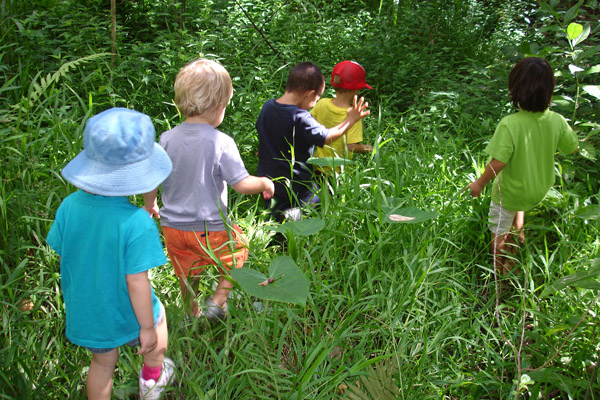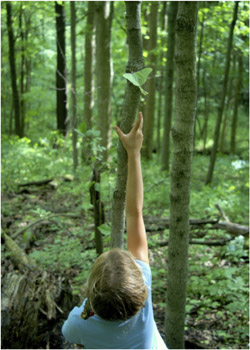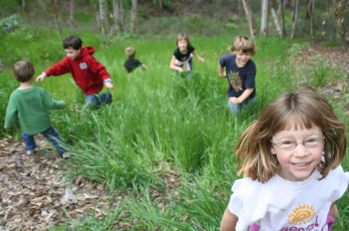
October 25, 2022
We each have an incredible gift: the ability to engage children with the world – indeed, the universe, that surrounds them and, of which, they are an integral part.
Working with children, our job is one of setting the kindling for the wonderful sparks of curiosity and deep interest to spring forth. While there may be a linear progression of lesson delivery in our albums, we don’t always teach that way, nor do we make overt and obvious connections between the seemingly disparate ideas and materials across the curriculum that we share.
We wait for the “ah-has.” It is up to the students, alone or collectively, to do the work of the synapses – to make those links, to leap the gaps between ideas towards a holistic understanding of everything around and within them.
There is a way of knowing that comes from being genuinely part of what you are attempting to understand. That is authentic knowledge rooted in sensorial experiences that tickle and surprise. By slowing down and taking our time, looking at the familiar from different perspectives, we can deeply explore the wild spaces around us. So it can be with the natural world outside the classroom.
When we venture forth into nature with children our intention is to make connections, becoming so familiar with the natural world that we receive it as a source of deep insight and practical wisdom.
Do we teach in a spontaneous way?
Is the time we spend with the children of ‘full value and authentic?
What role does nature play in our days?
Does it appear as trips out and about or as an integrated and seamless part of the children’s learning environment? Both?
What pedagogical value has the experience of wild places?

Finding the Wildness Within
As a classroom teacher, I remember fondly our studies in Human History: first examining and classifying the human animal; then drawing connections between our closest living relatives, and most recently to the epic stories of the earliest of humans and how they changed with and adapted to their dynamic living environments to suit their needs.
This part of the cultural curriculum is comprised of a series of presentations, discussions, and activities that highlight, at their roots, the unavoidable and startling idea for many of the children that we are part of the animal kingdom – in fact, from any part of the natural world.
Through our own evolution, humans have developed incredible technologies to use in the act of making our lives more comfortable and efficient. From the hand axe to the microprocessor, we have created incredibly complex tools and systems to better our collective lives.
Today, I wonder what has been subjugated; what primordial internal rhythms have taken a back seat through this process of discovery and creation? Not purposefully – just due to the ease and convenience of innovation. I would argue that for people living in the ‘developed’ world it is our instinctual knowledge that has been buried.
“To Touch and Feel is to Experience. Many people live out their entire lives without really Touching or being Touched by anything. These people live in a world of mind and imagination that may move them sometimes to joy, tears, happiness, or sorrow. But these people never really Touch. They do not live and become one with life.” – Hymeneyohsts Storm, in Seven Arrows (1972)
Perhaps, for many of us, the most readily accessible instinctual knowledge comes in the form of the oft-quoted ‘freeze, fight or flight response; that is, in times of sudden stress, the rush of adrenaline that our bodies feel prior to wishing for invisibility, throwing a punch or turning and escaping.
This is the visceral pull of our animal ancestry, the survival skill of our ancestors that kept them (and us) alive. It’s the surging feeling in our body when we narrowly avoid a car accident, for example. The rush is overpowering and memorable – a taste of what it felt like to be a wild predator or prey.
The instinctual skill set, of course, also includes a more subtle way of knowing: knowledge of the seasons, local and regional geography and weather patterns, the flora and fauna common to your home ground, etc.
Through our lives are we searching, questing for intimacy?
Can a profound connection to the natural – as the ‘other’ animals experience it – deepen, enrich and inform your life and way of living?
I believe so. I believe that there is a thirst within us all to regain the original knowledge of the Earth. Look at children as they play in the natural spaces around them. There is an intensity and exuberance expressed that appears so wonderfully organic. They appear to distill joy from their experience of the world.
“What a joy it is to feel the soft, springy earth under my feet once more, to follow the grassy roads that lead to ferny brooks where I can bathe my fingers in a cataract of rippling notes, or to clamber over a stone wall into green fields that tumble and roll and climb in riotous gladness!” – Helen Keller, in The Story of my Life (1903)
When was the last time you, as an adult, experienced such grounded elation and connection? Let us go out with our students and experience the world through the heightened and unencumbered senses of childhood.
Walking in the World
The traditional view is that there are two ways of interacting with the natural world, and with anything outside of yourself, I suppose: first, recognizing it as something similar to you, perhaps near enough to be considered part of you; and, second, as an ‘other’, outside and perceived as ‘distant’ from yourself.
The two views are not necessarily mutually exclusive. There is an overlap wherein resides the zone of integrating new ideas that inform one’s true self.
“I would like to learn, or remember, how to live…not so much to learn how to live as, frankly, to forget about it. That is, I don’t think I can learn from a wild animal how to live in particular–shall I suck warm blood, hold my tail high, walk with my footprints precisely over the prints of my hands? But I might learn something of mindlessness, something of the purity of living in the physical sense and the dignity of living without bias or motive.” – Annie Dillard, in “Living Like Weasels” from The Annie Dillard Reader (1994)

Sometimes when we venture outdoors with children we do so with a finite goal in mind, one big take-home message. When this agenda overrides the ‘draw of the wild and the will of the child’ we find ourselves frustrated, struggling to keep the students listening and focused on the guide or program.
When given the chance to explore a nature space many children can barely contain themselves – the urge to run, jump, sneak, creep, climb, crawl, sit quietly, and sing madly resonates within them so strongly. Let’s all remember to have fun out there – maybe even for the sake of pure joy itself!
“ I sincerely believe that for the child, and for the parent seeking to guide him, it is not half so important to know as to feel. If facts are the seeds that later produce knowledge and wisdom, then the emotions and the impressions of the senses are the fertile soil in which the seeds must grow. The years of early childhood are the time to prepare the soil. Once the emotions have been aroused – a sense of the beautiful, the excitement of the new and the unknown, a feeling of sympathy, pity, admiration or love – then we wish for knowledge about the object of our emotional response. Once found, it has lasting meaning. It is more important to pave the way for the child to want to know than to put him on a diet of facts he is not ready to assimilate.” – Rachel Carson, in Sense of Wonder (1965)
Begin by just going out, exploring, and experiencing – trying hard not to put limits on the form of exploration chosen. Hold too tight the reins, and you immediately suffocate the potential and possibility inherent to the child’s internal momentum and the game is up, lost. Just go out and see what happens. Then gather and share what the children discovered.
The next time that you venture forth, return to the same place (for there is comfort in the familiar) and change the format a bit: invite the children to sit quietly for five minutes, thinking, writing, and drawing. Then offer a chance for open sharing and cooperative reflection on the collective experiences.
“Don’t do something. Just sit there.” – Crazy Creek Company motto, Red Lodge, Montana USA
In the days and weeks that follow, extend the period of solitude and quiet until – when you call everyone back together it begins to take them longer and longer to pull themselves away. Then you know that the connections that they are making are from the heart and that the children have formed a dynamic friendship with nature that is very personal.
You can vary how you wrap up these experiences: sometimes with a period of sharing; at others, just a mellow gathering and return to the classroom. Often the quiet space following such a personal encounter serves as the fixer for a very memorable time out.
In time, the ecological literacy and emotional comfort that the children have developed transfer nicely to a deepening of more formal scientific studies and conservation service projects. Their newfound sense of belonging extends to a feeling of responsibility: not just do the children enjoy going out, for themselves – they are called to do it.
When we mindfully explore nature with children we facilitate a conversation between the child and the wildness of which s/he is a part. Let it take over.